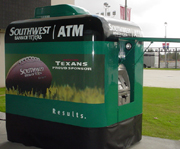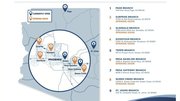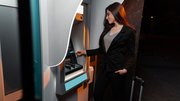News
Some FIs moved by ATMs
A rolling ATM gathers customers. At least that's been the experience of some financial institutions that have added mobile machines to their ATM programs.
March 8, 2004
A rolling ATM gathers customers.
At least that's been the experience of some financial institutions that have added mobile machines to their ATM programs.
Mark Himsel, vice president of Southwest Bank of Texas, said the bank's new mobile ATM has been "very busy" since its late October debut at Houston's 69,000-seat Reliant Stadium.
The bank, which already had eight machines at the arena, constructed a trailer for a ninth ATM at the request of the Houston Texans football team. Himsel said the unit is usually found in a busy area, which includes seating for some 5,000 fans plus a number of food concessions.
 |
The Southwest Bank of Texas mobile ATM at Houston's Reliant Stadium. |
While the actual number is a closely guarded secret, Himsel said the mobile ATM saw a 560 percent increase in dollars withdrawn at last month's Super Bowl XXXVIII.
Like the other Reliant Stadium ATMs, the mobile unit features a series of custom screen graphics, including a pair of denim jeans with the bank's name "stitched" onto a pocket - a popular design with crowds that attend rodeos at the arena.
"We want them to see our name throughout the transaction," Himsel said.
About 40 percent of its 95 ATMs boast similar graphics on high-resolution, color screens; Himsel said the bank expects to add more this year because graphics provide a lot of marketing bang for the buck.
As that number rises, Southwest Bank may upgrade its communications infrastructure to download graphics from a central server. Until then, however, "sneakers are pretty cheap," said Himsel, referring to the practice of manually loading graphics via CDs, often referred to as "sneakernet."
While Southwest Bank has been happy with transaction numbers at its mobile unit, Himsel said the ATM's primary function is to make it easier for customers to access cash in convenient locations. If the unit's popularity continues to grow, the bank may add a second one -- perhaps in Dallas, where it recently purchased Lone Star Bank, a five-branch, $223 million financial institution.
"We want to be out in the neighborhoods and the communities where we need to be," Himsel said.
"It's a nice way to connect with the community," agreed Patty Henneke, head of ATM Banking at U.S. Bank, which owns a pair of vans, each equipped with two machines.
The first was introduced in 1997, with a second vehicle added a few years later. Between them, the vans have logged some 250,000 miles, traveling to such high-profile events as the Kentucky Derby and the Rose Bowl.
"It's really great to have a service you can provide to communities going through hard times," Henneke said, noting that the vans were able to reach southern Californians fleeing their homes during last October's wildfires.
The trickiest aspect of mobile ATMs, Henneke said, is telecommunications. U.S. Bank's vans are equipped to connect ATMs to networks via dial-up, wireless or VSAT (satellite) technologies.
"We obviously prefer dial because it's the least expensive option, but we've got all three methods because we never know where (the vans) are going to end up," Henneke said. "In California, for example, we couldn't use VSAT because of all the smoke."
Those kinds of hassles have led some financial institutions to eliminate their mobile ATMs. Wells Fargo, for instance, retired its five mobile units after about five years on the road. According to a Wells Fargo spokesperson, the mobile units weren't being used enough to warrant the costs.
"Mobile ATMs were used, particularly at festivals and other events, to familiarize customers with the machine and the technology. Now that ATMs are more mainstream, this need has lessened," the spokesperson said.














